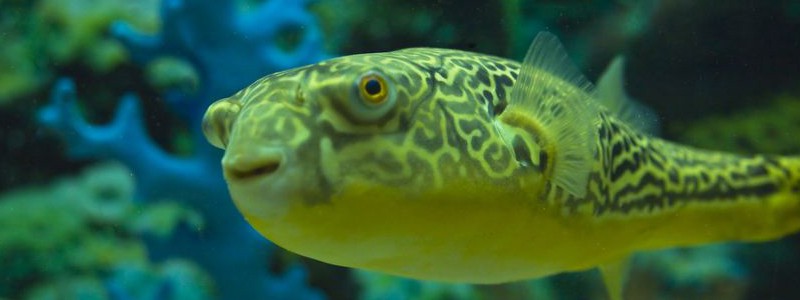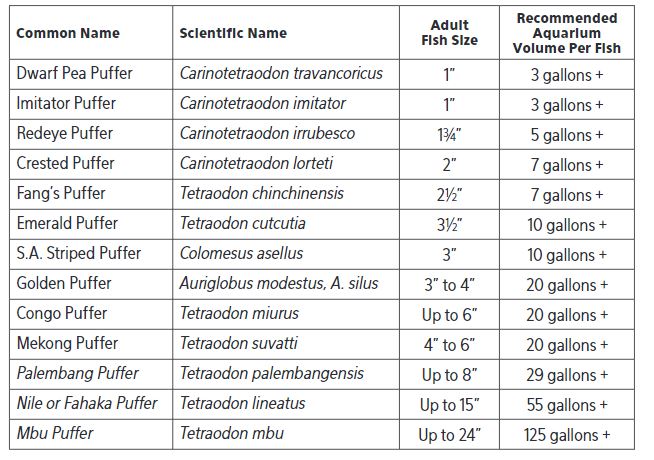- Your cart is empty
- Continue Shopping
FreshWater Puffer Care
Faces

Puffer fish are best known for their ability to inflate their bodies to avoid being swallowed by larger fish, but their “E.T.” – like faces and unique personalities are what attract people to them and lead many who keep them to consider them a true pet. They learn to recognize their human companions, greeting them enthusiastically when they approach the aquarium and will even hand feed. Puffer fish can be found in the ocean, brackish estuaries and freshwater habitats around the world. Some species move back and forth between different environments on a regular basis. Of the approximately 150 known species of puffer fish, fewer than 30 are considered strictly freshwater, and they are the focus of this care guide.
A Freshwater Puffers Natural Habitat
Freshwater puffers are found in river systems throughout Southeast Asia, parts of India and Bangladesh, the Amazon basin in South America, and the Congo, Nile and other rivers in Africa. The Gold-ringed or Mbu Puffer is even found in Lake Tanganyika! A few species occur in open water, but most are found along riverbanks often among submerged plants. They live in tropical and temperate climates.
Water Requirements for Freshwater Puffers
Freshwater puffers do best at a pH between 7.0 and 7.6, with the temperature between 74° and 78° F. Aquarium salt should not be added to a freshwater puffer aquarium unless it is used to treat diseases. This should not be confused with brackish water species such as Figure 8 and Green Spotted Puffers, which are frequently kept in fresh water in aquarium shops and sold as such. Brackish water puffers can be adapted to freshwater, but when kept this way, they tend to be more susceptible to diseases, especially ecto-parasites like Ich and Oodinium. If the aquarium is kept in a room below 74°, use a trusted aquarium heater brand to maintain the correct water temperature. Maintain good filtration and do a 10% water change every week or 25% every 2 weeks using an Aqueon Aquarium Water Changer or Siphon Vacuum Gravel Cleaner. Don’t forget to treat tap water with Aqueon Water Conditioner before refilling your aquarium!
Housing Requirements For Freshwater Puffers
The freshwater puffer aquarium should be well decorated and include caves, grottos and overhangs to provide shelter and hiding places. Aquarium size depends on which species you want to keep. For example, Dwarf Pea Puffers (C. travancoricus) can be kept in aquariums as small as 5 gallons, while other species need 20 gallons or more per fish. Some larger species don’t need as much space as you would expect based on their size because they spend most of their time motionless. Below is a list of recommended aquarium sizes for typically available species:

Freshwater puffers can be fin nippers, and some are downright aggressive and/or predatory. Some species, like Dwarf, Redeye and Golden Puffers, can be kept together or with other fast-moving fish like danios. Others, such as Mekong, Nile and Mbu Puffers, must be kept solitary. For the most part, freshwater puffers should be considered species tank fish. Always consult an aquarium professional before purchasing puffer fish for your aquarium.
Do Freshwater Puffers Eat?
Smaller species are omnivorous and will thrive on a varied diet that includes Aqueon Tropical Flakes, Color Flakes, Spirulina Flakes, Tropical Granules, Algae Rounds, Bottom Feeder Tablets and Shrimp Pellets. Frozen foods should also be fed as treats to improve growth and color. Larger species can be fed Aqueon® Cichlid pellets, Monster Fish Medley and frozen foods. Do adequate research on your fish’s food requirements and make sure you can provide for them before purchasing them.
Freshwater Puffers’ Breeding Level – Difficult
Freshwater puffers are known to breed in captivity, although it is rare in home aquariums. Many species are cave spawners. Commercial captive breeding is becoming more common.
